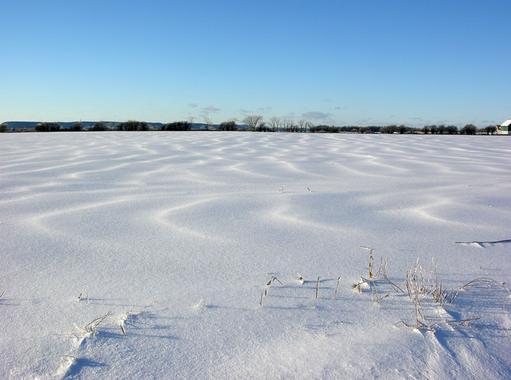 As we look out at the snow-covered fields of Zeeland Township, MI, on this cold February morning, it’s hard to imagine any living critters in the soil surviving the frozen west Michigan winter. But somehow they do! And come spring, the microbes, worms, beetles and fungi will erupt with new activity, helping to produce new life on our farms and in our yards. But how cold is too cold for the survival of soil life? Can microbes live in the Antarctic, where air temperatures regularly linger around -50 degrees Fahrenheit? The answer is– surprisingly– yes! From the Soil Science Society of America: Soils located in polar regions are unique to those found elsewhere, as they contain permafrost. Permafrost is a thick subsurface layer of soil that is frozen year round. In Antarctica, during the coldest parts of the year, the entire soil system is frozen solid. Because of this, the soil is actually very dry, like in deserts! If this is true, wouldn’t it be impossible for living creatures to survive there? Antarctica surely looks like a lifeless, barren area… Amazingly, there is life in Antarctic soils. Even in these extreme environments, scientists have been able to find soil microorganisms alive and thriving. What scientists have found is that these tiny organisms are able to survive by living in microscopic films of water that stick to soil particles (adherence). The bond energy between water molecules and soil particles is so great that it prevents the thin layer of water from freezing, even at extremely low temperatures. Microbes live in this unfrozen water, which allows them to stay alive even during the long deep freeze of winter. These microbes aren’t just surviving, either. During the winter, they are still consuming organic matter, “exhaling” carbon dioxide (CO2) and maintaining their populations. They are actually alive, not even hibernating! You may wonder why scientists are willing to spend their time researching soil microbiology in such remote areas. Studying organisms in extreme and inhospitable environments like the Arctic and Antarctic allows scientists to make inferences about life on other planets. This type of research is also important for understanding how cold ecosystems function now, and how that might change in response to global climate change. Scientists are already starting to observe increased microbial activity in the polar regions. As temperatures rise, microorganisms are predicted to consume more soil organic matter, which could lead to the release of even more CO2 (a greenhouse gas) into the atmosphere. Most of us don’t live in Antarctica, but in the northern parts of the hemisphere, it’s pretty cold in February. If you think you’ve got it bad, try to be inspired by the mighty polar microbes. They are some pretty tough organisms, and because of this, they can teach us very much. At Good Sweet Earth, in order to more effectively treat lawns and gardens naturally and organically, we believe it’s important to fully understand soil and all of the life found within– even if that soil is found at the South Pole! That’s why we are members of organizations like the Soil Science Society of America. If you would like to put our knowledge and expertise to work in your yard this year, get in touch with us at Office@GoodSweetEarth.com. Or check out the products and services we offer.
0 Comments
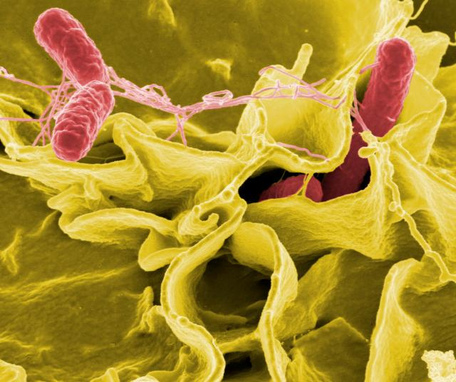 There are billions upon billions of microbial inhabitants living in your yard’s soil, and a lion’s share of that population comprises bacteria and fungi. Those terms often illicit a negative reaction from us– they make us think of diseases and moldy food. So what about the bacteria in our soil? Can it make us sick or cause diseases? Well, according to University of Purdue agronomy professor Ron Turco, the answer is most likely no. “Most of the bacteria in soil can’t directly cause disease, as they don’t have the necessary biochemical abilities,” Dr. Turco recently said in a Q&A for the Soil Science Society of America. In fact, for soil to be healthy, it needs a lot of bacteria, and it needs a wide variety of bacteria (and fungi and nemotodes, etc.) Dr Turco goes on to explain the diversity of microbial life found in healthy yards. It’s estimated that the number of bacteria in soil is more than 100 million per gram of soil (dry weight equivalent); we also estimate there are 6,000 to 8,000 different types of bacteria per gram of soil. More surprising is the fact that the structure of the population can vary in the landscape over relatively short distances. While many bacteria are technically mobile, in soil they are more likely found attached to the soil surface, and most of their movement is controlled by the water flowing through soil pores. Soil bacteria live in small clumps called micro-colonies that are attached to the soil surface. These micro-colonies tend to be associated with small soil aggregates, and the combination offers a form of protection from drying and predators (primarily protozoa). It also enhances the opportunity for genetic exchange. So what does that bacteria actually contribute to the soil? Why does healthy soil need all this life? Dr Turco explains that too. Soil microorganisms are responsible for breaking down plant residues and other carbon (C) inputs [fertilizers] and converting nitrogen (N) within the N-cycle. Because of their soil surface attachment strategy, their actions are also a fundamental part of the soil formation process. In terms of activity and what soil bacteria are doing most of the time, we find that they are often “resting.” That’s because the large, bacterial population uses up the available nutrients quickly and then spends most of its time waiting for new food to arrive: residue inputs, fertilizers, waste materials, etc. Ambient water and temperature conditions also have a major impact on the actions of the bacteria; they are the most negatively affected by low water availability and high temperatures. In general, the ideal conditions for plant growth are also the ideal conditions for microbial activity. And the diversity? Why do we need lots of different kinds of bacteria? The critical point is that the soil doesn’t contain just one type of bacteria or one set of abilities (enzymes). It’s also not full of pathogens, nor are all the bacteria in soil active all the time. Instead, soil activity changes with fluxes in moisture, temperature, and substrate input. In order to respond to an ever-changing array of inputs, the soil biology is biochemically (enzymatically) diverse in its ability to utilize foods and electron acceptors. This diversity gives soil its resilience. It’s critical for your soil to have a variety of microbes living in it. A strong microorganism population also attracts macroorganisms– things like beetles, earthworms, centipedes, etc– which benefit your soil (and plants) as well. So if you’re looking to give your soil a microbial boost– whether for your lawn or garden– Good Sweet Earth Worm Tea is a great place to start. Our Worm Tea, applied as a microbial drench or foliar spray, can introduce a variety of beneficial microbes to your lawn or garden. We brew our Worm Tea with a blend of collected rain water and aquifer water, organic black strap molasses, kelp and our own all-natural vermicompost. We sell it by the gallon for gardeners, CSA shares for growers needing a bit more, and we can also apply a Worm Tea drench directly to your lawn several times a year to give your grass a boost. If you’re interested in giving your soil an infusion of life, get in touch with us about our Worm Tea at office@GoodSweetEarth.com or call us at 616-594-0693. 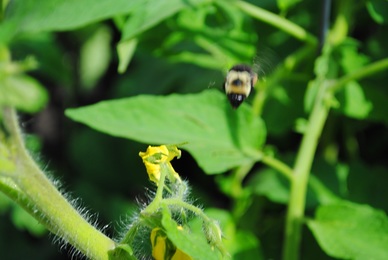 If you were to ask us to sum up in one sentence our vision for Good Sweet Earth, it would be the headline of this post– Healing the planet, one yard at a time. We got started in the vermicompost business many years ago because we wanted to offer safer alternatives to chemical fertilizers and soil amendments. We expanded into lawn fertilization and garden services because we didn’t think there were enough organic alternatives available for people to care for their turf and home-grown fruits and veggies. Chemicals are killing our soil. Corporate farming practices are killing our soil. Without healthy soil, our planet is doomed. So in order to save our soil, it’s our mission to encourage people to do three things: 1) Use less chemicals on their lawns and gardens, 2) Grow more of their own fruits and vegetables, instead of buying them from supermarkets, and 3) Support sustainable family farms. To encourage the use of less harsh chemical fertilizers, we offer organic vermicompost and natural blends for your soil. And when a homeowner hires us to care for their lawn or garden, we teach them sustainable ways to treat pests and weeds– no harsh chemicals necessary! To encourage people to grow more fruits and vegetables in their own gardens, we offer season-long crop consulting services— that’s a fancy way to say we’ve got a certified Master Gardener on staff who will walk you through your growing season, from selecting seeds and mapping out your garden to starting your seedlings and pest control to harvesting your bounty. Finally, to support sustainable family farming, we encourage our customers to shop at local farmers markets. This is a great way to actually see the people who are growing your food, locally. No mealy, chemical-filled tomatoes grown in hot boxes in California, no soil-damaging farming practices utilized to grow corn. Just small family farms. We also donate a portion of our profits to organizations that support sustainable agriculture, like Farm Aid and the West Michigan Environmental Action Council. That means when you purchase products or services from us, you’re supporting west Michigan's natural resources and family farms. At the end of the day, having a healthy yard is the most tangible step many of us can take toward having a healthier planet. And by buying Good Sweet Earth products or services, the money you spend on organic yard care will have the potential to heal the planet well beyond the edge of your yard. Which then means we really can heal the planet, one yard at a time. For more information about lawn or garden services, or our organic Worm Compost, shoot us an email at office@GoodSweetEarth.com. 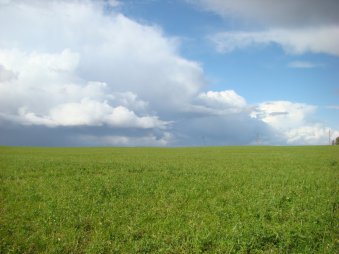 You know that smell in the air after a good rain? Or that smell that permeates the air when you dig into your garden’s soil every spring? Did you know there’s a scientific explanation for that smell? The science behind that wonderful “fresh earth” aroma is geosmin. Geosmin is an organic compound produced by a microorganism found in all soil, and it carries a distinct aroma and flavor. It’s what gives beets their earthy flavor. Sometimes if you drink water that’s been sitting out for a while, it develops a musty taste, and that, too, is caused by geosmin. Wine is known to pick up this flavor as well. The flavor produced by geosmin isn’t always a pleasant one, but the aroma it gives off is quite pleasing to the senses. So where does that smell come from, and why do we get whiffs of it after a nice heavy precipitation? It’s pretty simple: When it rains, water fills the air pockets found in the soil, and the geosmin gets expelled into the air. Sometimes you’ll even get an earthy whiff of geosmin before it rains. How, you ask? Well, a low-pressure system can de-gas the soil and put those geosmin into the air before a drop of water even hits the ground, leading many of us to say things like “It’s gonna rain; I can smell it!” Read more about geosmin from the Soil Science Society of America. 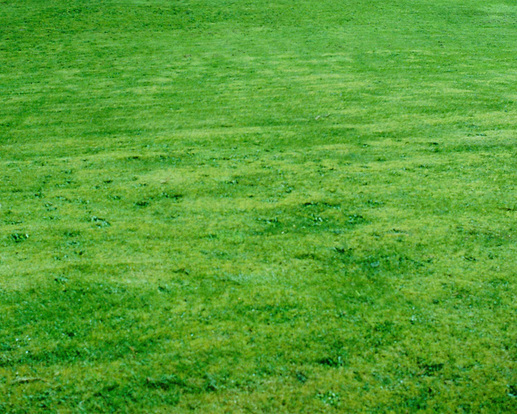 Want to know the secret to having healthy, thick, lush grass in your yard? Well, aside from applying Worm Tea to your lawn instead of chemical fertilizers, I'll give you two easy organic tricks that'll help give you a healthier lawn. 1. Mow smarter. This means mowing less and setting your lawn mower to the highest setting when you do mow. The roots of your grass mirror the blades you see above-ground. If you whack your grass blades down to a half-inch or an inch every seven days, your lawn's roots will never really have the chance to penetrate the soil. Without deep roots, you'll have a weak lawn-- it won't handle foot traffic well, it will be susceptible to disease and pests, and it won't be able to handle dry conditions. Also, lose the bag on your mower. Grass clippings provide some great nutrients to your lawn. When you leave the grass mulch on your lawn, and you apply Worm Tea, the mulch serves as a food source for the microorganisms in the Tea. The microorganisms break down the mulch and release nutrients into the soil. Organic matter being broken down by bacteria, fungi and other microbes-- this is the all-natural way of providing nutrients to plants that the planet has been employing for thousands of years. No need for lab chemicals. 2. Water smarter. This means turning your sprinkler on only when necessary. Instead of watering your lawn every day for 10 minutes, water once every 7-10 days for 35-45 minutes. And if it's rained within the past 10 days, don't bother watering at all. Also, if your grass looks good, it might not even need a watering. Allowing water to go deep into your soil means your lawn's roots will follow the water deep into your soil. Those short waterings most people do mean water stays near the surface and evaporates. The roots never go very deep because the water never goes very deep. Watering in the morning is the best time. Watering after 11am means the hot sun will evaporate too much surface water, and watering in the evening promotes bad fungal growth. Also, when you turn the sprinkler on too often, it introduces more nasty chemicals to your soil-- like chlorine, which is added to water to kill bacteria. Bacteria, however, is an absolutely essential component to healthy soil. That means every time you apply water to your lawn from your hose, you're killing billions of beneficial microorganisms. Limit this by watering less frequently. Finally, the best day to water is the day before you apply Worm Tea. That way, any beneficial bacteria you kill with the tap water from your hose (which has chemicals like fluoride, chlorine, etc) will be replaced the next day. So here's an ideal scenario for mowing and watering: Day 1. Mow your lawn. Keep it at a length of 2-3 inches, and let the clippings fall onto your lawn. Day 2. Water for 35-45 minutes at around 8am. Day 3. Apply Worm Tea to your lawn to replenish the microorganisms lost with your watering and to break down the grass clippings. Day 4-8. Enjoy your lawn with friends, family and pets! Day 9. Mow, if necessary. During hot summer months in Michigan, grass goes dormant, so it's often not necessary to mow as often. Day 10. Water for 35-45 minutes. Day 11. Apply Worm Tea. Repeat! |
